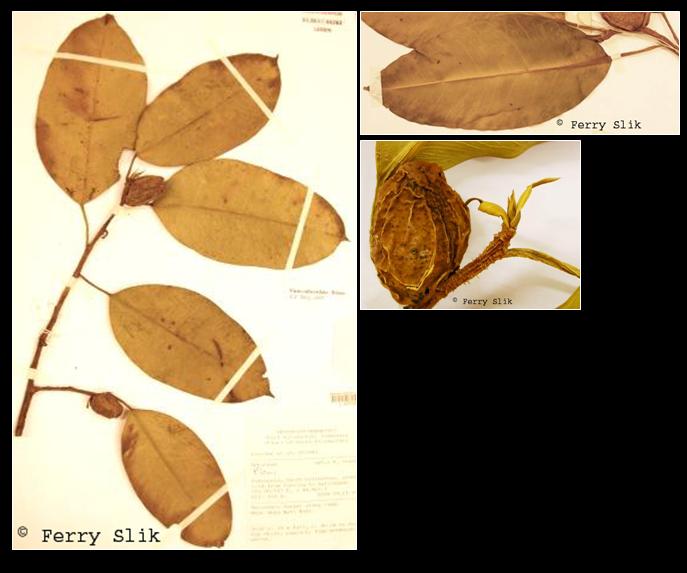Ficus subcordata Blume, Bijdr. (1825)
Latin for 'similar to Ficus cordata', which is now a synonym of Ficus elastica.Synonyms
Ficus acrorhyncha Summerh.
Ficus balica (Miq.) Boerl.
Ficus calophylloides Elmer
Ficus fairchildii Backer
Ficus garciniifolia Miq.
Ficus polygramma Corner
Ficus subcordata var. malayana Corner
Urostigma balicum Miq.
Urostigma subcordatum (Blume) Miq.
Diagnostics
Upper canopy tree (strangler) up to 45 m tall and 64 cm dbh. Stem with white
sap. Stipules ca. 23 mm long, glabrous to hairy. Leaves alternate, simple, penni-veined,
secondary veins placed close together and inconspicuous, glabrous. Fruits ca. 35
mm long, yellow-orange-red, elongate figs, placed along the twigs.
Description
Strangling deciduous tree, without aerial roots, up to 45 m tall and 70 cm in diameter;
branching starts 2 m above the ground and twigs are brownish-grey; in shallow soil the lateral
roots near the soil surface can spread 4-7 m away from the base of the trunk. Bark whitish-grey,
slightly smooth and fissured, flexible and durable, 10-17 mm thick; inner bark whitish, exuding
white sap. The blunted spearhead-like bud extends from the node while the leaf is still intact.
Leaves alternate, oblong, ovate-oblong, or elliptical, 9-20 cm x 4-10 cm, with a prominent light
green midrib and a light green petiole of 2-5 cm length; leaf margin entire; leaf-blade broadly
cuneate or rounded at base, pointed at apex, smooth to hairy, purple when young, light green
beneath and dark green above when mature. Fruit a short-ellipsoid fig, 3-5 cm x 2-2.5 cm, solitary,
occasionally in pairs, green when young, gradually turning from yellow to reddish-brown or black
when ripe. Seeds small, hard and numerous. Weight of a fresh fruit ranges from 10-20 g, and there
are 1000-2000 ripe seeds per g. [from PROSEA]
Ecology
In slightly disturbed to undisturbed mixed dipterocarp and sub-montane
forests up to 1000 m altitude. Both on alluvial sites as well as ridges.
It tolerates a wide range of soil types, growing well on limestone-based soil.
Uses
The foliage is used as a feed supplement during the wet season and as the sole diet during
the dry season for ruminants in some dryland farming areas. The young fruit can be fed to
ruminants. The wood is used as fuel for brick and limestone kilns, and the smaller branches
are used for household firewood. The mature stem is used for farmyard posts. The bark is used
for making string for farm tools. The timber is not hard enough for building houses, making
farm implements or woodcarving. The tree is used as shade for livestock, for storing crop
residues, for reclamation of denuded land, for protecting soil on sloping land and as a
windbreak.
Distribution
From Indo-China and Thailand to the Solomon Islands.
Local names
Borneo: Kayu ara.
Indonesia: bunut lengis (Bali), wunut (Javanese), sipadi (Sumatra).
Philippines: marabotum (Bagobo), balete (Tagalog), tibi (Bikol).
Thailand: sai (Nakhon Si Thammarat).
